
The Old Masters
A Heritage of Humanity
THE GREAT MASTERS from Giotto to Corot and Manet and later, through their art have reflected the ideas, the thoughts and the style of societies long gone. When we look at an Old Master we see at first hand how people lived at that period, their dress, the interior of their homes, how the countryside looked then but also something of their history. Through their eyes we see the development of their ideas and how their view of the world unfolded.
The earliest painting in this collection is a rare Greek icon that traces its style back one thousand years from the 12th century to the 1st century Hellenistic Roman portraits of Egypt at El-Fayûm and Antinoe.
The gold-background Madonna and Child with saints from the South-East region of Italy shows the influence of the great Florentine Master Giotto. It was painted around the fourteenth century and shows how Italian art was gradually moving away from the influence of Byzantium painting. The Italian High Renaissance is represented by the superb image of a beautiful Florentine woman painted in the 1550s by Ghirlandaio. The eighteenth shows paintings of young girls by the French artist Jean-Baptiste Greuze and by the the Welsh Old-Master Richard Wilson's 1750s portrait of the tragic Miss Wynne.
The Old Master's familiarity with classical art, literature and Old Testament writings is seen in the Judith with the head of Holofernes attributed to Carl Fabritius and The Finding of Moses by Valerio Castello. The Roman legend of Coriolanus, Gnaeus Marcius, by the Bordeaux painter Brascassat and the Three panels, Air, Earth and fire by the Flemish painter Jan van Kessel are other examples of classical themes used by Renaissance and later classical artists...
These images are rare and unique. You may decide to acquire hand-pulled prints of these Old Masters to form a corporate art collection. They will enrich the working environment, both your own and that of your staff. Using images of rare Old Masters to design a prestigious company report or beautiful letterhead, for example, you are building better customer relations, a readier acceptance of your company and its services and your clients' perception of a superior quality product. Framed and ready to hang, these beautiful images make a superb collectors item for the sophisticated home. Old Master Paintings belong to humanity, we merely look after them for the next generation. Begin your own tradition.

Panagia Glikophilousa (Mother of God)
12th century Icon of, possibly, middle eastern origin showing strong influence of the Constantinople workshops of the preceding centuries.
 Large image, details and buy
Large image, details and buy
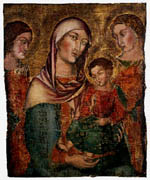
Madonna and Child with Saints
Italian 14th century Icon from the south-east (Abruzzi) region of Italy. The gold background painting on a canvas and timber support shows the strong Sienese influence, which was spreading extensively in the region, and elsewhere, at the time.
 Large image, details and buy
Large image, details and buy
Saint Marzela Icon
Gold-background, timber supported Icon of the Quattrocento, showing the influence of Byzantine painting from eastern Italy. The identity of Saint Marzela is currently unknown.
 Large image, details and buy
Large image, details and buy
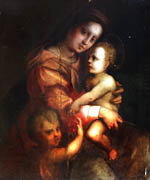
Holy Family with Saint John
Domenico Puligo, a Florentine painter working between 1492 - 27. His style is Late Mannerist. Collaborated with Andrea del Sarto with whom there is a close stylistic affinity. He is a student of Ridolfo del Ghirlandaio (see painting p37 n12).
 Large image, details and buy
Large image, details and buy
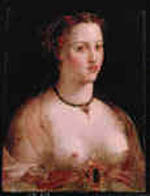
Nuptial Portrait
Painted by the Florentine painter Michele Tosini in the period 1503-77. A pupil of Lorenzo di Credi, he took the name of the artist, Ridolfo di Ghirlandaio (1483-1561), with whom he collaborated on various paintings.
 Large image, details and buy
Large image, details and buy

Crucifixion
A stripcartoon-like panorama of the Passion of Christ, painted in the 1520s by the German artist Bernhard Strigel (c.1465/70 - c.1528)
 Large image, details and buy
Large image, details and buy

Fête Champetre
Cornelis Cornelisz van Haarlem 1562-1638. The style of the artist's mythological paintings owes a debt to the school of Fontainebleau. His Mannerist style is somewhat similar to that of his Haarlem contemporaries Hendrick Goltzius and Carel van Mander.
 Large image, details and buy
Large image, details and buy

Nativity with Shepards
Johann Rottenhammer I Munich, 1564/5 - Augsburg, 14 Aug 1625
 Large image, details and buy
Large image, details and buy
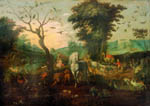
Noah's Ark
Noah's Ark is one of Jan Breughel de Velours (Velvet Breughel) - 1568-1625 - most renowned subjects, chosen by the artist to display his skill in depicting exotic animals, flowers and landscapes. Collaborated with Peter Paul Rubens on some of his most important paintings including the renowned Christ in the House of Martha and Mary in the National Gallery of Ireland.
 Large image, details and buy
Large image, details and buy

S.Catherine
Hendrik van Balen (Antwerp 1575-1632) is a master of Peter Paul Rubens and Anton van Dyck. He collaborated with Rubens and with Jan Breughel de Velours (see no.p46 n13).
 Large image, details and buy
Large image, details and buy

Girl with Bouquet of Flowers
Hendrik van Balen Antwerp 1575 ?1632 The Flemish artist trained and often collaborated with Anthony van Dyck and Frans Snyders. He is frequently the author of the figures appearing in the paintings of Jan Breughel de Velours. He was known for his religious paintings and altarpieces (see id p54 n20)
 Large image, details and buy
Large image, details and buy

Fauns and Nymphs
A rare painting by the ill-fated Dutch artist Johannes Torrentius (1589 - 1644). A member of the underground religious sect, the Rosicrucians, he was jailed for twenty-two years by the Authorities. Fauns and Nymphs entered Charles l of England's collection when the artist escaped there, and bears the ruler's seal on the rear. Returning to Holland Torrentius was again arrested and died in prison.
 Large image, details and buy
Large image, details and buy
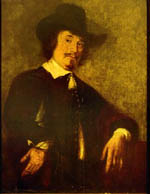
Portrait of Jan van Goyen
Portrait of Jan van Goyen. This portrait of the important Dutch landscape painter (1596 - 56), is similar to a known portrait of the artist, done about a decade later, by Gerard Terborch in the Prince of Liechtenstein Collection, Vaduz.
 Large image, details and buy
Large image, details and buy
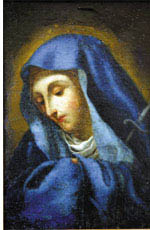
Madonna Dolorosa
Style of Sassoferrato (Giovan Battista Salvi) Sassoferrato, 1609 - Rome, 1685
 Large image, details and buy
Large image, details and buy

Girl Playing a Mandolin
In the style of Judith Leyster, Haarlem 1609-1660. The wife of a noted painter Jan Molenear, she is known for her genre and figure paintings. The latter often show young people playing musical instruments
 Large image, details and buy
Large image, details and buy
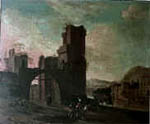
Italian Landscape with Figures
Jan Asselijn, (1610-52) a Dutch artist, is a member of the mid 17th century Italianite school: painters who studied in Italy. Their work often betrays the landscape of the Roman Campagna.
 Large image, details and buy
Large image, details and buy

Adoration of the Magi
The artist Benjamin Gerritsz Cuyp (1612-52) shows the strong influence that he absorbed from the later, sombre style of Rembrandt. (See no 0602-128) He is a relative of Aelbert Cuyp (see id no 0204-0007)
 Large image, details and buy
Large image, details and buy
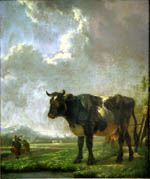
Milkmaid with Cattle
Attributed to the Dutch painter Aelbert Cuyp (Dordrecht 1620-91) for the artist's brushwork and the treatment of the grass foreground, somewhat similar to its treatment in 'Milking Cows,' catalogue no.49 in the National Gallery of Ireland.
 Large image, details and buy
Large image, details and buy

A Dutch Farm
Isack van Ostade (1621-49) The subject, full of atmosphere, is typical of this talented but short-lived painter; buildings set off against a well observed sky.
 Large image, details and buy
Large image, details and buy

Italianite Landscape with Ruins on Coast
Italianite Landscape with Ruins on Coast.. Karel du Jardin. (c.1622-1678)
 Large image, details and buy
Large image, details and buy
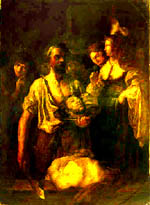
Judith with the Head of Holofernes
The prototype of this painting is in the Rijksmuseum (Inventory Ag1) where it was previously attributed to Carl Fabritius. The present painting is important because it shows the lower section of the painting which, in the Rijksmuseum version, has been cut away. The painting, by a Rembrandt pupil, shows the influence of Rembrandt?s sombre later style.
 Large image, details and buy
Large image, details and buy
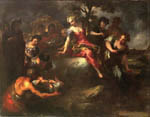
The Finding of Moses
Valerio Castello, A painter of the Baroque Genovese School 1624 - 59 His technique was warm and intense. The artist painted the subject onto a red, earth-based priming, common to this school.
 Large image, details and buy
Large image, details and buy
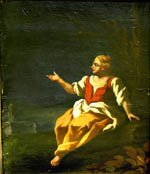
Girl seated by a Well
Attributed to Nicolas Berchem, Haarlem 1620 - Amsterdam 1683. An artist typically working in the Italianate style of the period, influenced by his sojourn, about 1640, in Italy. The influence of the Cuyp school is visible in the red-faced young woman. See ID p65 n23
 Large image, details and buy
Large image, details and buy

Allegory of Water
Jan van Kessel, Flemish artist (1626-79) who collaborated closely with Jan Breughel de Velours (see no.p46 n13) This is one of a series of three panels, Air, Water and Fire
 Large image, details and buy
Large image, details and buy

Allegory of Fire
Allegory of Fire. Jan van Kessel, Flemish artist (1626-79) who collaborated closely with Jan Breughel de Velours (see no.p46 n13) This is one of a series of three panels, Air, Water and Fire
 Large image, details and buy
Large image, details and buy

Allegory of Air
Allegory of Air. Jan van Kessel, Flemish artist (1626-79) who collaborated closely with Jan Breughel de Velours (see no.p46 n13) This is one of a series of three panels, Air, Water and Fire.
 Large image, details and buy
Large image, details and buy

The Poet Virgil
The Poet Virgil. One of a series of paintings done by the Italian (Calabrian) painter, Mattia Preti (1630 -90). He, like numerous painters from the region, was much influenced by Caravaggio's use of light and shade. This painting is a good example of the technique
 Large image, details and buy
Large image, details and buy

The Sculptor in his Studio
Gerard Thomas (Antwerp 1633 - 1720/1)
 Large image, details and buy
Large image, details and buy

The Artist in his studio
Gerard Thomas, Antwerp 1633-1720/1. The painting shows the actual working conditions of artists in Holland at the period.
 Large image, details and buy
Large image, details and buy

Dutch Portrait of a young Man
Portrait of an unknown young man. Netherlands or Flemish school of about 1640.
 Large image, details and buy
Large image, details and buy
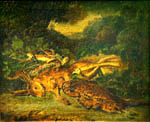
Still Life with Game
Painting from the workshops of the Flemish Breughel family of circa 1650
 Large image, details and buy
Large image, details and buy

Shepherd with Cattle
Dutch School painting of the mid 17th century. There is a stylistic reference to the Paulus Potter Painting of Cattle, ref.no.252, in the Wallace Collection
 Large image, details and buy
Large image, details and buy

Classical Landscape with figures
Attributed to Jan Frans van Bloemen (1662-1749), known as `Orizzonte`, a Flemish painter who specialised in Italian landscapes of the Roman Campagna. The horizon and back plane is an important feature of his landscapes, hence his nickname
 Large image, details and buy
Large image, details and buy
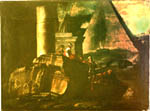
Roman Ruins with Caio Cestio's Pyramid tomb
Giovanni Paolo Panini (c.1692 - 1765/8) The artist shows contemporary and classical figures in a landscape of Roman ruins that contains Caio Cestio's Pyramid.
 Large image, details and buy
Large image, details and buy

Crucifixion
Artist : Grani, 1750s Venetian School. The bright clean colours reflect the influence of the seventeenth-century Venetian School and particularly, the paintings of the Italian Rococo Era Painter, Gianbattista Tiepolo. (1696-1770)
 Large image, details and buy
Large image, details and buy
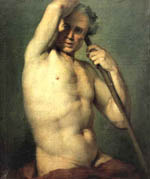
Classical Figure
Jean Baptiste Chardin, studio. A life-long member of the French Academy, this three-quarter length work shows the attention to detail and elegance associated with the best French academic painting of the 1750s.
 Large image, details and buy
Large image, details and buy

Shepard in the Roman Campagna
Considered the masterpiece of the German 'Italianite' painter Rosa da Tivoli (Pieter del Roos) 1657 - 1706, the work was painted, and signed and dated on the back, in 1703
 Large image, details and buy
Large image, details and buy
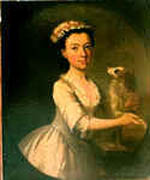
Portrait of Miss Elizabeth Wynne
Portrait of Miss Elizabeth Wynne. A member of an aristocratic Welsh family, she was painted by her countryman Richard Wilson (1713?-82).
 Large image, details and buy
Large image, details and buy

Portrait of a Lady
Attributed to Phillip Hussey Irish painter. Cork 1713 - Dublin 1783. Worked principally in Dublin. His chosen subjects are single portraits of which this painting is a typical example, and groups. The style is outside the academic mainstream current in both London and Dublin at the period.
 Large image, details and buy
Large image, details and buy

Wicklow Landscape
The painting is a typical Barrett Romantic Irish landscape. The artist, born in Dublin, 1728 was a founder member of the Royal Academy and a friend of Edmund Bourke whos advice contributed to the development of his virtuoso style. He died in London 1784
 Large image, details and buy
Large image, details and buy
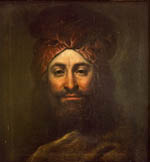
Man with a Turban
John Henry Fuseli, Zurich 1741-London 1825. Like his contemporary William Blake the dominant influence on his art is Mannerism and Michelangelo that he saw in 1770 in Italy. His friendship with Sir Joshua Reynolds resulted in Fuseli being elected a Royal Academician in 1790.
 Large image, details and buy
Large image, details and buy
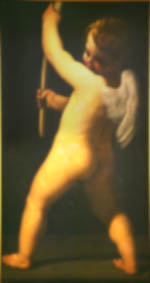
Playful Cherub
James Barry, Ireland, Cork 1741- London 1806 The Irish painter was the prot?g? of Edmund Bourke and one of the founder members of the Royal Academy. Political infighting resulted in Sir Joshua Reynolds having him expelled, April 15, 1799. His work is in the Grand Manner of the period and was praised by Dr Johnson and William Blake.
 Large image, details and buy
Large image, details and buy

Vestal Virgin
Painted by the French artist Jean-Baptiste Greuze (1745-1805). His art was described by Diderot as glorifying virtue in a period of moral
 Large image, details and buy
Large image, details and buy

Allegorical Figure
Jan Baptiste Greuze (1745 - 1805) (See painting p66 n24)
 Large image, details and buy
Large image, details and buy

The Lakes of Killarney
Attributed to, Jonathan Fisher, (fl.1763-1809) A View of the Lower Lake, Killarney with classical figures
 Large image, details and buy
Large image, details and buy

Rustic English Landscape
George Morland (1763 - 04) is one of the few Genre painters of the English school who successfully followed and adapted the style of the Dutch artists, David Teniers and Adriaen Brouwer. Like Torrentius (see no.0602-126) he also died in prison.
 Large image, details and buy
Large image, details and buy
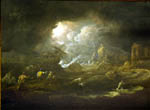
Wreck of the Killarney
William Sadler (1782c.- 1839). Painted on to oak panel covered in hessian onto which the artist laid a gesso priming. More details on the painting see Caring for Old Master Paintings.
 Large image, details and buy
Large image, details and buy

Irish Romantic landscape
On the basis of a painting in a similar style in the collection of Bristol museum, Conway Castle, this painting is now tentatively attributed to the Irish painter Francis Danby 1793-61. It was formerly given to another Irish painter James Arthur O?Connor, 1792 ca. - London 1841 who is believed to have studied under the landscape artist William Sadler c.1782-1839 (see No. 0204-0004).
 Large image, details and buy
Large image, details and buy

Dutch Landscaoe, Abraham Hulk
Abraham Hulk (Holland 1813-England1897)
 Large image, details and buy
Large image, details and buy
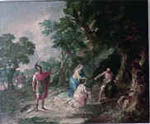
Coriolanus
Jacques-Raymond Brascassat 1831. Coriolanus, Gnaeus Marcius, the 5th century General being persuaded by his wife Volumnia not to march on Rome.
 Large image, details and buy
Large image, details and buy
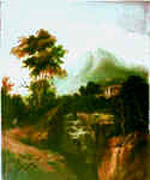
Romantic 19th century landscape.
Painted by the English(?) painter H.V.Maxwell in 1833
 Large image, details and buy
Large image, details and buy

Girl reading a letter
Wilson, (Thomas?) 19th century English School.
 Large image, details and buy
Large image, details and buy

Irish Thatched Cottage with Figures
The painting, by an unknown artist, shows an Irish mountainous landscape with figures in front of a thatched cottage. The Romantic style of the oeuvre would place it in the mid nineteenth-century
 Large image, details and buy
Large image, details and buy